On Thursday evening, one of the English football’s fiercest derbies took place as Tottenham Hotspur hosted bitter rivals Arsenal.
In the Premier League era, the Gunners have always been atop the mountain, spitting down at their underperforming, languishing adversaries. For the vast majority of Arsene Wenger’s era, the North London derby was viewed as a David versus Goliath fixture. However, unlike the infamous parable, Goliath usually squashed David.
Nevertheless, towards the back end of Wenger’s superlative reign at Highbury and later the Emirates, the tide shifted. But David didn’t grow to the size of Goliath, Goliath shrank in competitive stature.
Both clubs have fallen down the ladder in recent seasons but are desperately trying to climb back up as close to the top as possible, rung by rung. A good start would be by finishing in the top four once more. There is just one obstacle in the way for the two great rivals – each other.
Unfortunately for Arsenal, Spurs were victorious this time around, closing the gap to one point, keeping the battle for the fourth spot very much wide open with just two games remaining.
This article will be a tactical analysis of the North London derby during the week. We will focus specifically on the tactics which were key to Spurs picking up a vital three points to close the gap to just one point.
Lineups and formations
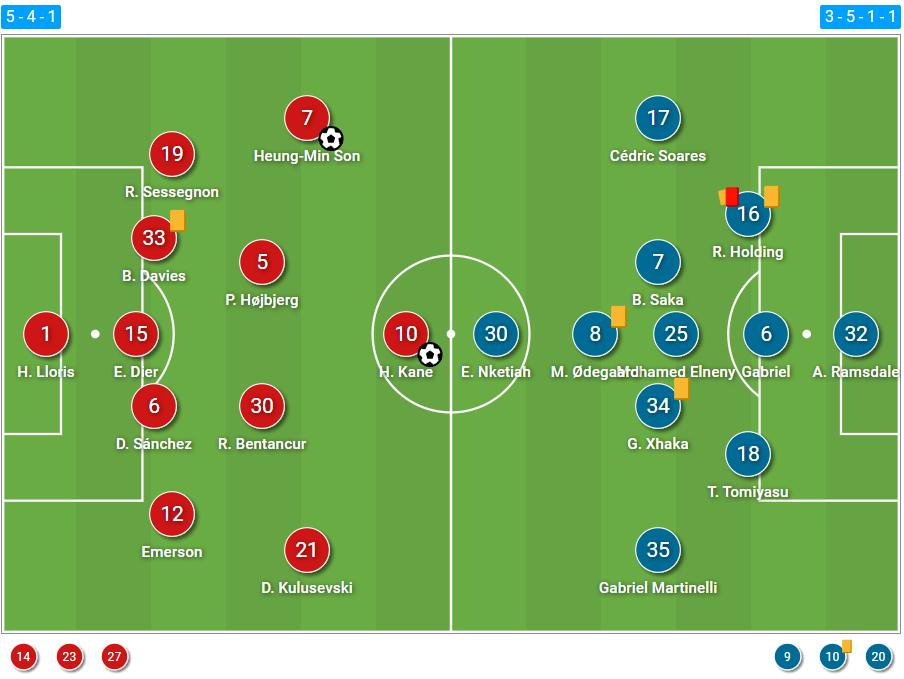
Once Antonio Conte settles with a formation, there becomes very little leeway for tactical adaptation from the stubborn Italian. The ex-Chelsea and Internazionale boss has been using the 3-4-2-1 since arriving at the Tottenham Hotspur Stadium, and so it should be of no surprise that the Lilywhites lined up in this structure on Thursday night.
The renowned tactician made just one change to the starting eleven which inflicted a potentially fatal blow to Liverpool’s title hopes last Saturday in that beguiling 1-1 draw at Anfield.
The switch was forced too, as an injured Cristian Romero was replaced by Davinson Sánchez at the right of the back three. The rotation wasn’t a hindrance to Spurs though who kept the Gunners firing blanks, keeping a clean sheet for their efforts.
Unlike his perverse counterpart, Mikel Arteta has been far more open to formational flexibility in the past. However, given the excellent form Arsenal have found themselves in throughout the current campaign, the Basque coach’s use of the 4-2-3-1 has remained prevalent in possession.
Wyscout have identified Arsenal’s shape as a 3-5-1-1 because of the side’s structure out of possession but it was very much a 4-2-3-1/4-3-3 on the ball which will be explained later in this analysis.
On top of this, the young manager made absolutely no changes to his starting lineup from the team that disposed of Championship-bound Leeds United at the weekend with a 2-1 victory at the Emirates Stadium.
This game was set to be an edgy, close, and rigidly tactical affair between two coaches with very contrasting philosophies on how the game should be played. One staying true to his belief of executing powerful, unpredictable attacks with plenty of automatisms and unpredictability, with the other being a firm disciple of perpetual positional play and succinct passing patterns. Unfortunately, the fixture was anything but close.
Catenaccio vs Juego de Posicion
This game was not one for lovers of high pressing. Both sides were more willing to drop off and defend in deeper areas of the pitch than apply pressure in the final third. This was particularly evident from Tottenham within the first fifteen minutes of the match.
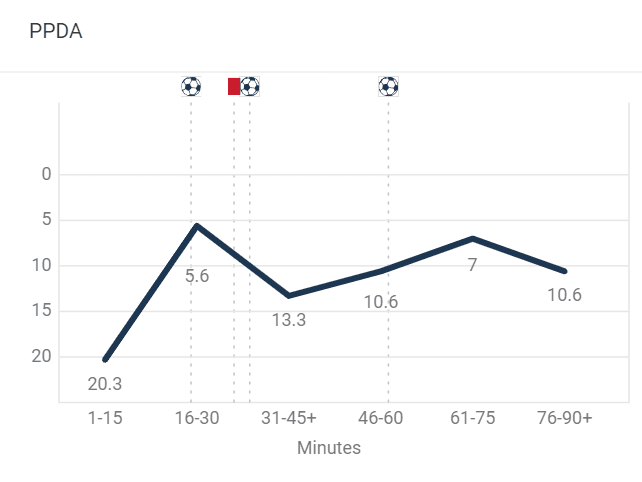
Spurs’ Passes allowed Per Defensive Action rate was at a high of 20.3 on average within the opening quarter of an hour. Tottenham were happy to cede possession to their great London rivals, allowing Arsenal to pass the ball relatively unscathed in their own half of the pitch.
Conte instructed Spurs to configure in a 5-2-3/5-4-1 mid-to-low block when Arsenal were in possession of the ball, denying access to the central areas of the pitch and forcing the Gunners wide, generally to Cedric Soares or Takehiro Tomiyasu.
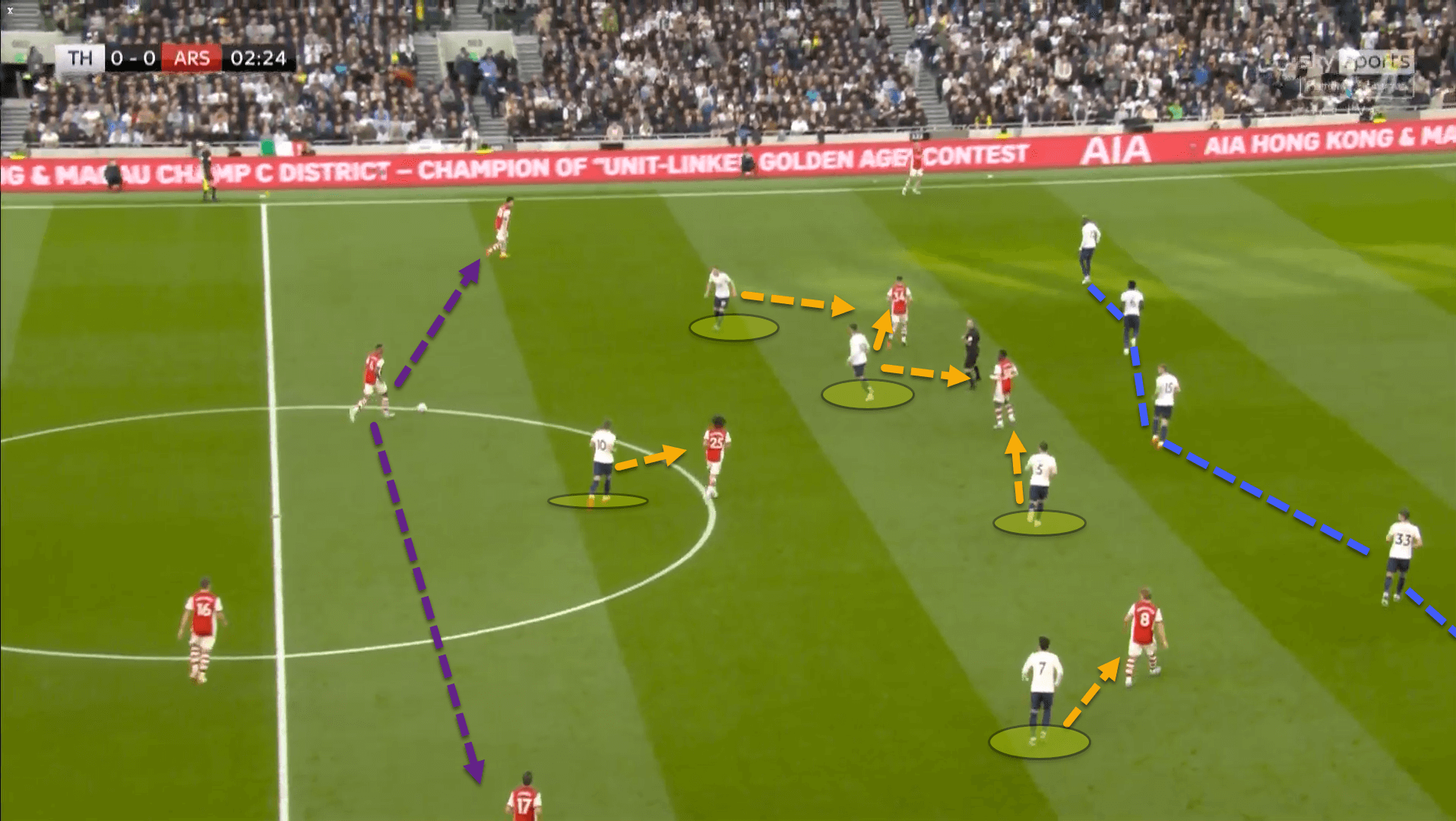
Conte’s side would remain very compact, especially within the midfield, because Arsenal tend to position at least three players between the lines in these higher phases.
As can be seen from this example, Granit Xhaka, Martin Ødegaard, and Eddie Nketiah are pushed up into this area. Spurs’ midfield four are very close together, working cohesively to block off passing lanes as well as pick up players in their zones. Meanwhile, Harry Kane has dropped off onto the revitalised Mohamed Elneny to prevent passes into the Egyptian.
Providing this was successfully employed by Spurs – and more often than not, it was – Arsenal would be forced to play to the fullbacks. The hosts would then shift the defensive block across, cutting off any progressive passing angles down the line or back inside.
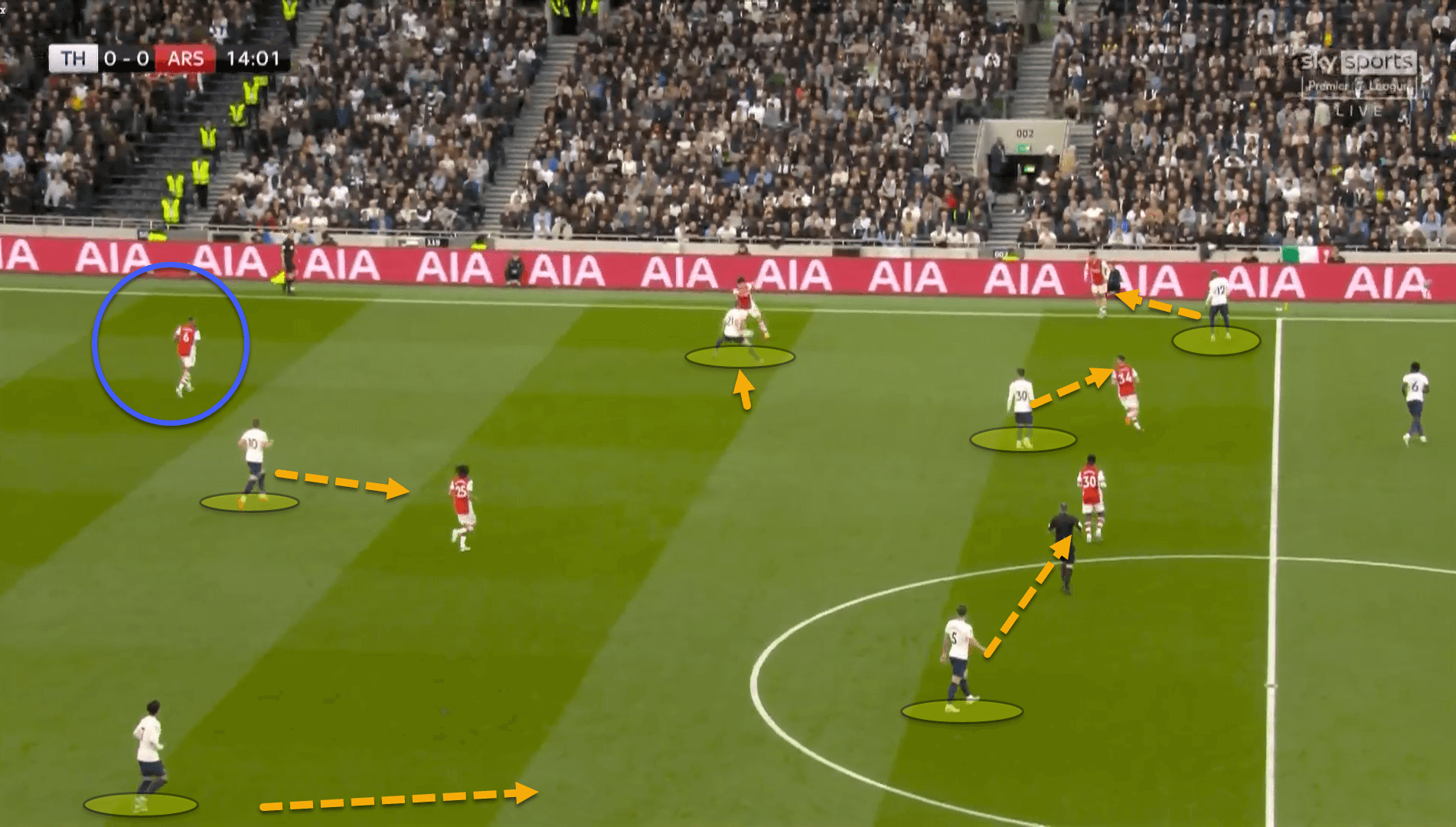
Spurs left the passing lanes to Arsenal’s centre-backs open. In doing so, the fullback’s only viable solution was to pass back to the central defenders.
This then became a trigger for Spurs to step up as a unit to press quickly and try to force a turnover of possession in a dangerous area.
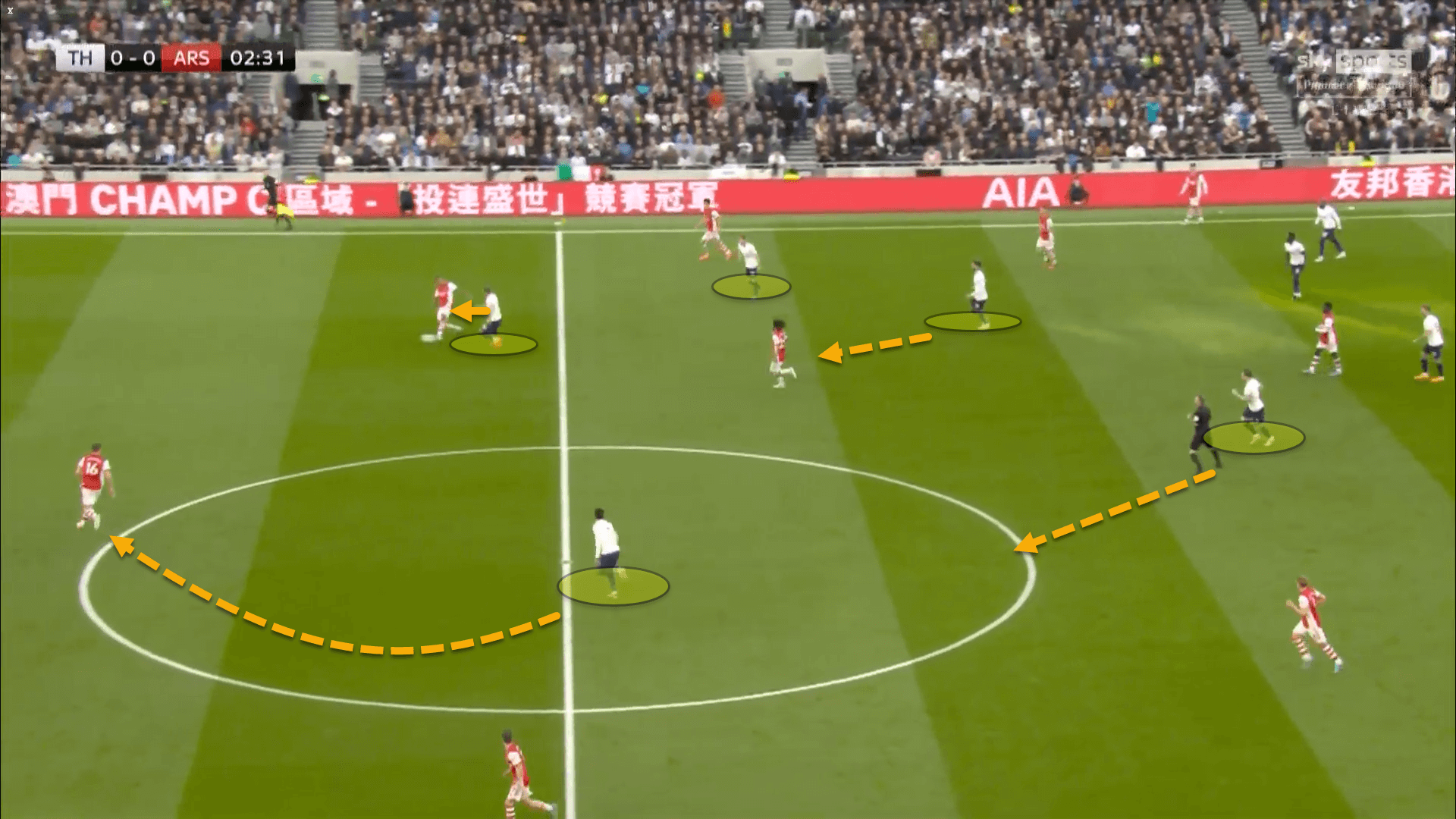
Spurs were incredibly sound defensively. Arsenal severely struggled to reach the final third at all. Throughout the match, the Gunners completed merely 28 passes to the attacking third. Their average this season has been 42.17 per match.
Of course, this was inflated Rob Holding’s red card, but credit should still be slapped on Spurs for successfully deploying such an unyielding defensive structure throughout, replicating a beautifully modernised Catenaccio style that Nereo Rocco himself would be proud of. True Italianism is alive and well in North London.
Arsenal’s back five
Despite the obvious similarities between Arteta and Pep Guardiola, the former takes a far more conservative approach in the defensive phases.
After the game, many criticised Arsenal’s approach against Spurs, claiming that the visitors should have been more pragmatic and sat in a low block, looking to hit their opponents on the break instead of being the protagonists. However, Arsenal did do this for large parts of the match.
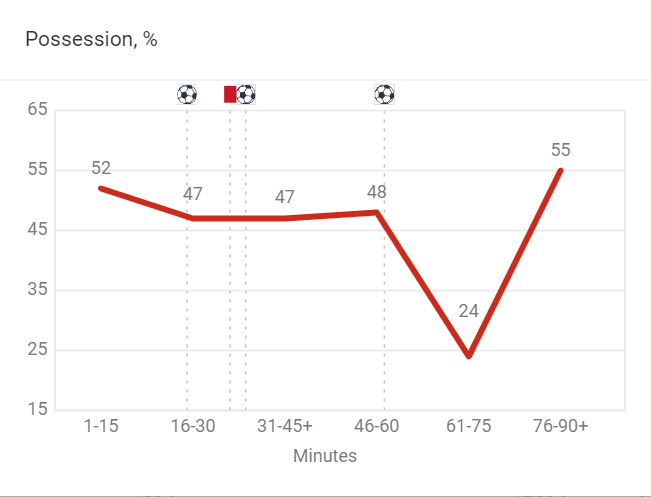
It’s redundant to say that the sending off was the reason behind Arsenal’s change of approach after the fifteen-minute mark where they went from being the aggressors to the defenders. Holding was sent off in the 33rd minute. The Gunners were averaging just 47 percent of the ball until that point from the 16th minute onwards.
In fact, Holding’s red card didn’t really affect the possession share until the hour mark when Arsenal’s numbers dropped drastically.
So now let’s look at Arsenal’s defensive set-up throughout the North London derby and how it changed after Holding’s dismissal.
Arteta’s men began pressing in a 4-1-4-1 shape which became a 3-1-5-1 once the fullbacks engaged with Spurs’ wingbacks.
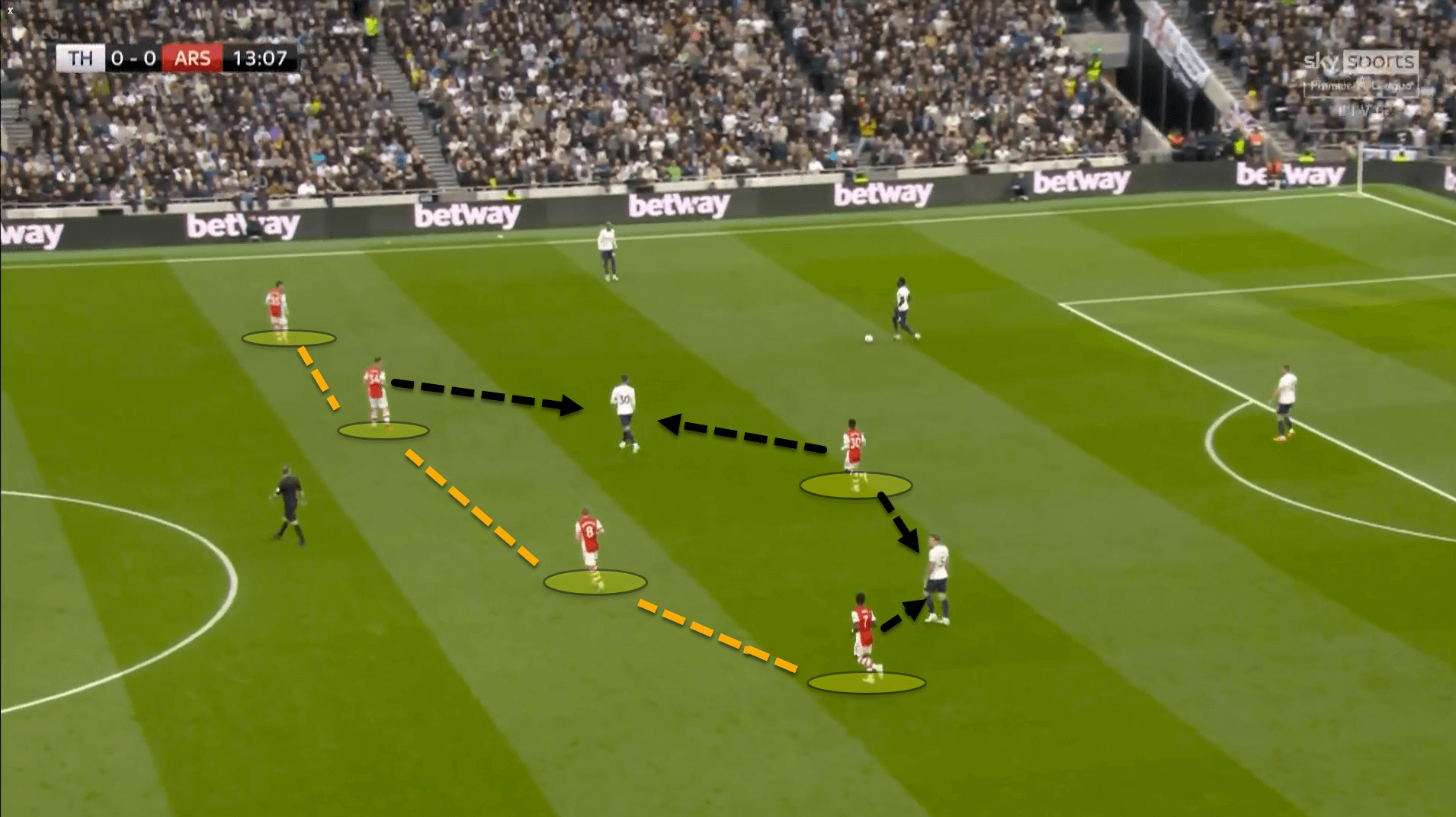
Xhaka would leave his position as part of the double-pivot and push up next to Ødegaard to create the second bank of four. Arsenal’s objective was to prevent access into Spurs’ two holding midfielders, Pierre-Emile Højbjerg and Rodrigo Bentancur.
If the ball was switched out to Tottenham’s left flank, Cedric would quickly step up to press, creating the 3-1-5-1 that was spoken about previously, with Martinelli marking Emerson Royal on the opposite side.
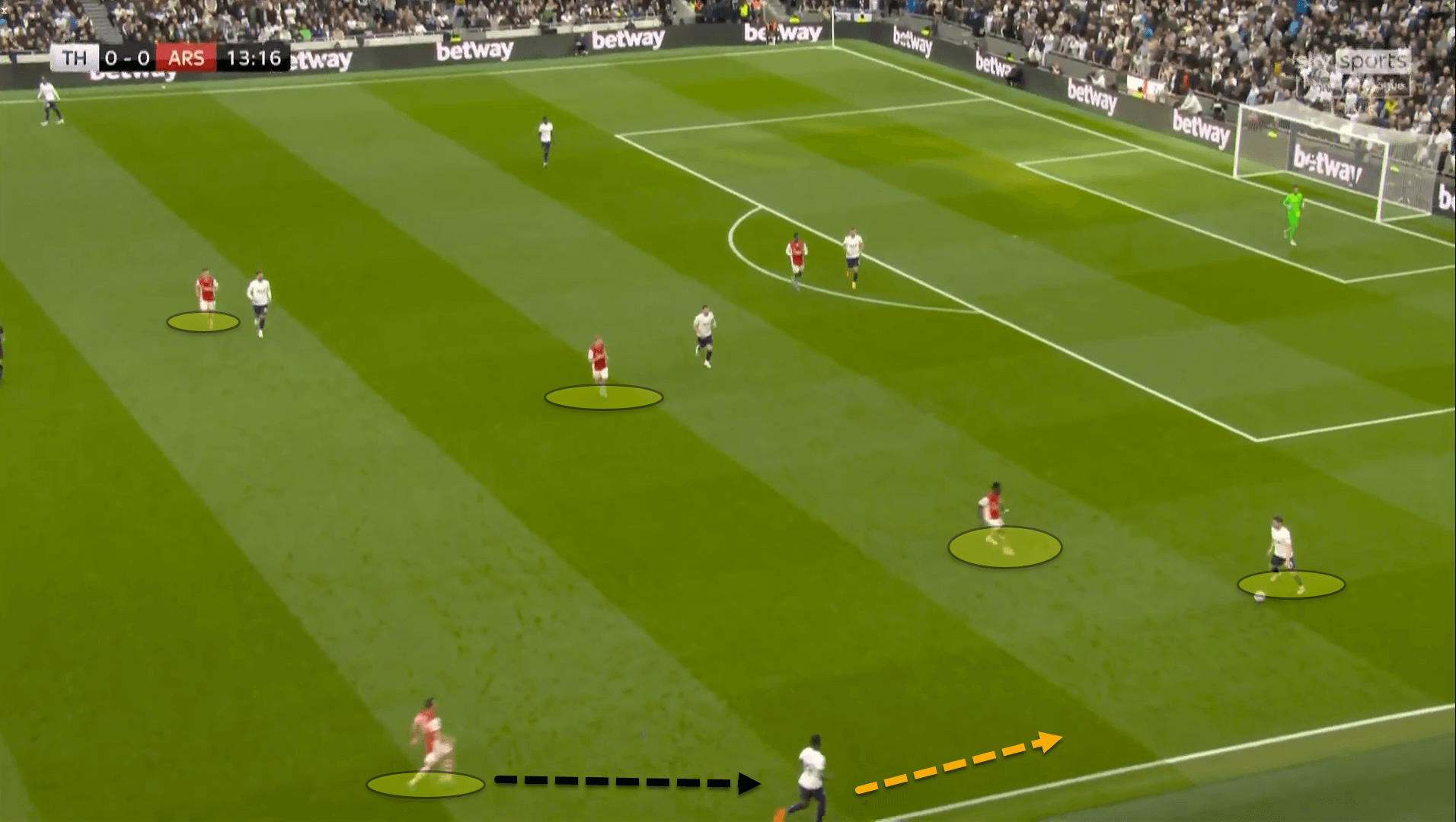
If Spurs broke through Arsenal’s lopsided pressing shape – and more often than not, they did – the Gunners would drop off into a 5-3-2 low block. The reason for this was to deny Spurs the ability to play to Kane as well as to limit the space Tottenham’s three forwards and wingbacks had to run into.
In a similar manner to Jurgen Klopp’s Liverpool, if Spurs can’t work the ball into dangerous positions in the final third, the centre-backs will often try and find runners in behind. In fact, it was this type of movement that led to Holding’s red card as Heung-Min Son attempted to attack the depth in behind the former Bolton Wanderers man.
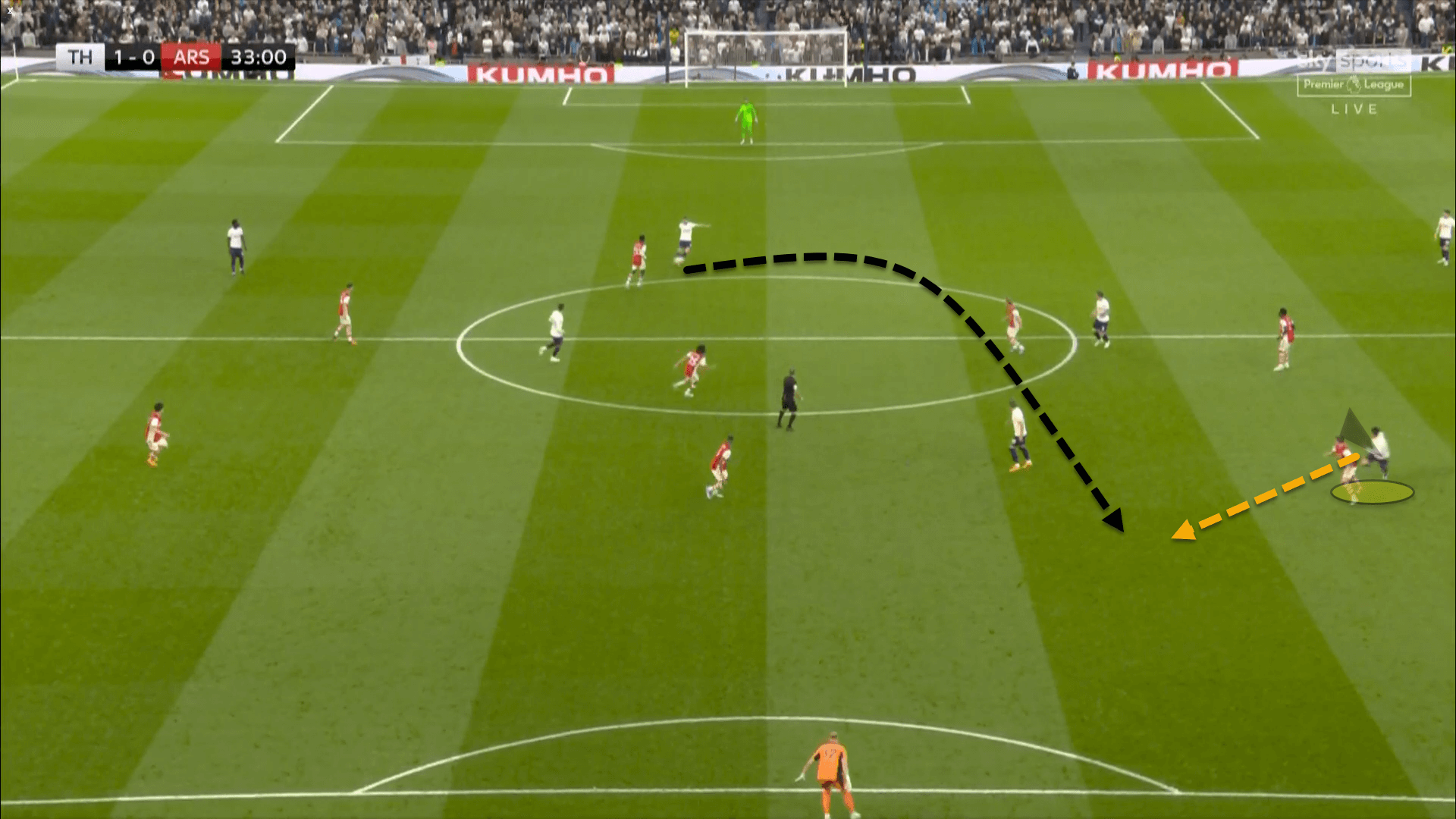
These diagonal runs have been deadly at times under the Italian boss and so Arteta set out to reduce the space between Aaron Ramsdale and the defenders by dropping into a 5-3-2 shape with Martinelli acting as a wingback out of possession to keep a watchful eye on Emerson.
Bukayo Saka tucked inside as a right central midfielder with Ødegaard popping up next to Eddie Nketiah to create a two-man first line of pressure against Spurs’ back three.
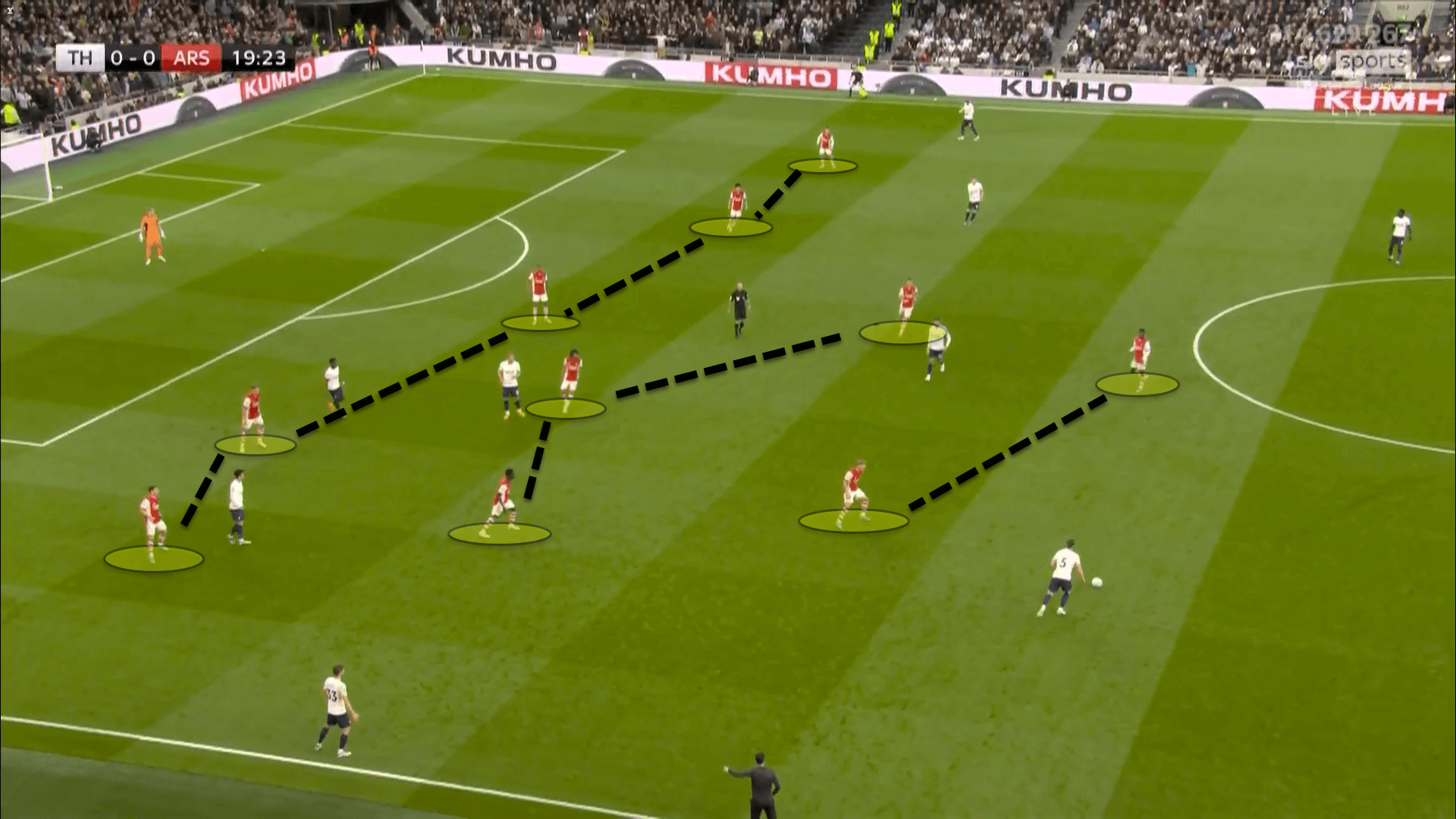
To Arsenal’s credit, these balls over the top from Spurs’ backline were dealt with relatively well and so the low block’s natural spatial limitation worked a treat for the Basque alchemist.
This tactical approach did not change too much once the red card occurred. Xhaka simply became a left-sided centre-back due to his versatility while Ødegaard fell back into the midfield, leaving a 5-3-1 shape.
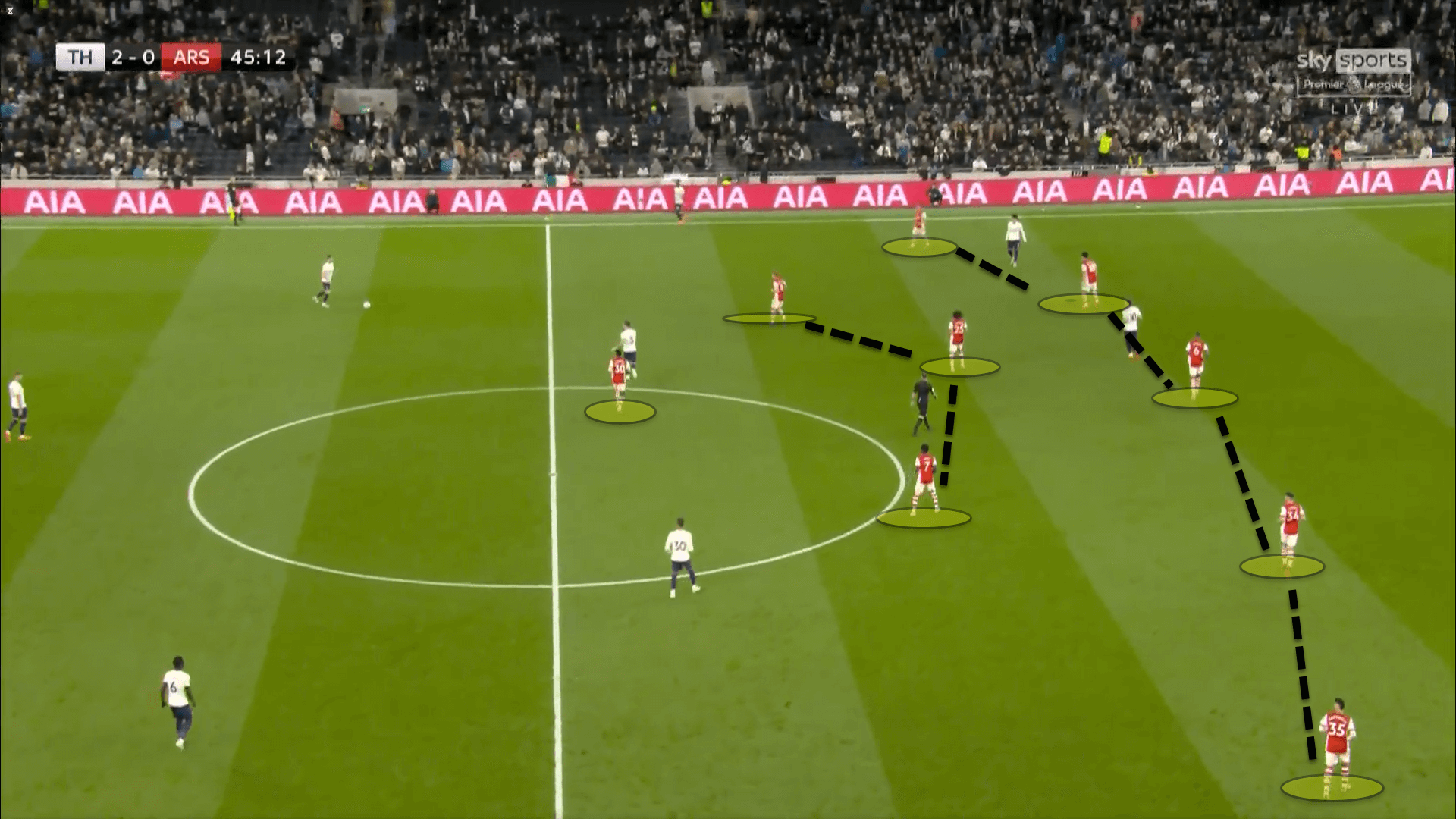
Defensively, Arsenal’s PPDA sky-rocketed as the game wore on. Spurs dominated possession, while the Gunners floundered in transition and were insensible on the ball at times.
Arsenal boasted a PPDA of an incredibly high 31.1 on average in the second half as they were pinned back and forced to defend against wave after wave after wave of demoralising attacks from the home side.
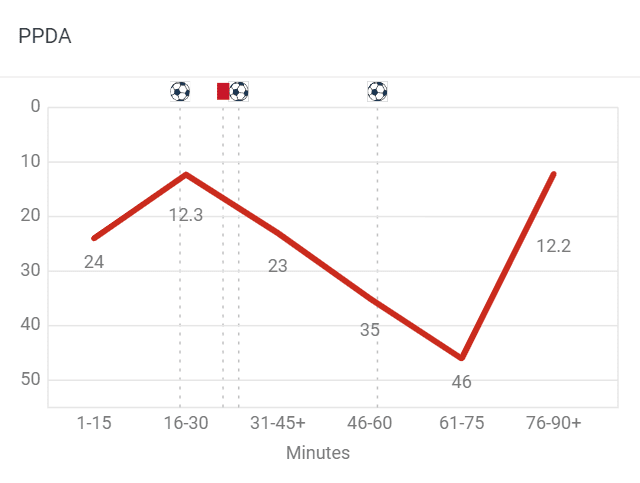
Gunning down the Arsenal defences
Up against a team nicknamed the Gunners, it was Spurs who were firing throughout the match. Antonio Conte’s men were relentless with their attacking, creating 31 positional attacks with 35 percent leading to a goalscoring opportunity, more than one in three.
Arsenal’s formation out of possession was very compact in the central corridors but left quite a lot of space out wide, especially beside the central midfielders and in front of the wingbacks, which is a major weakness in a 5-3-2/5-3-1 formation.
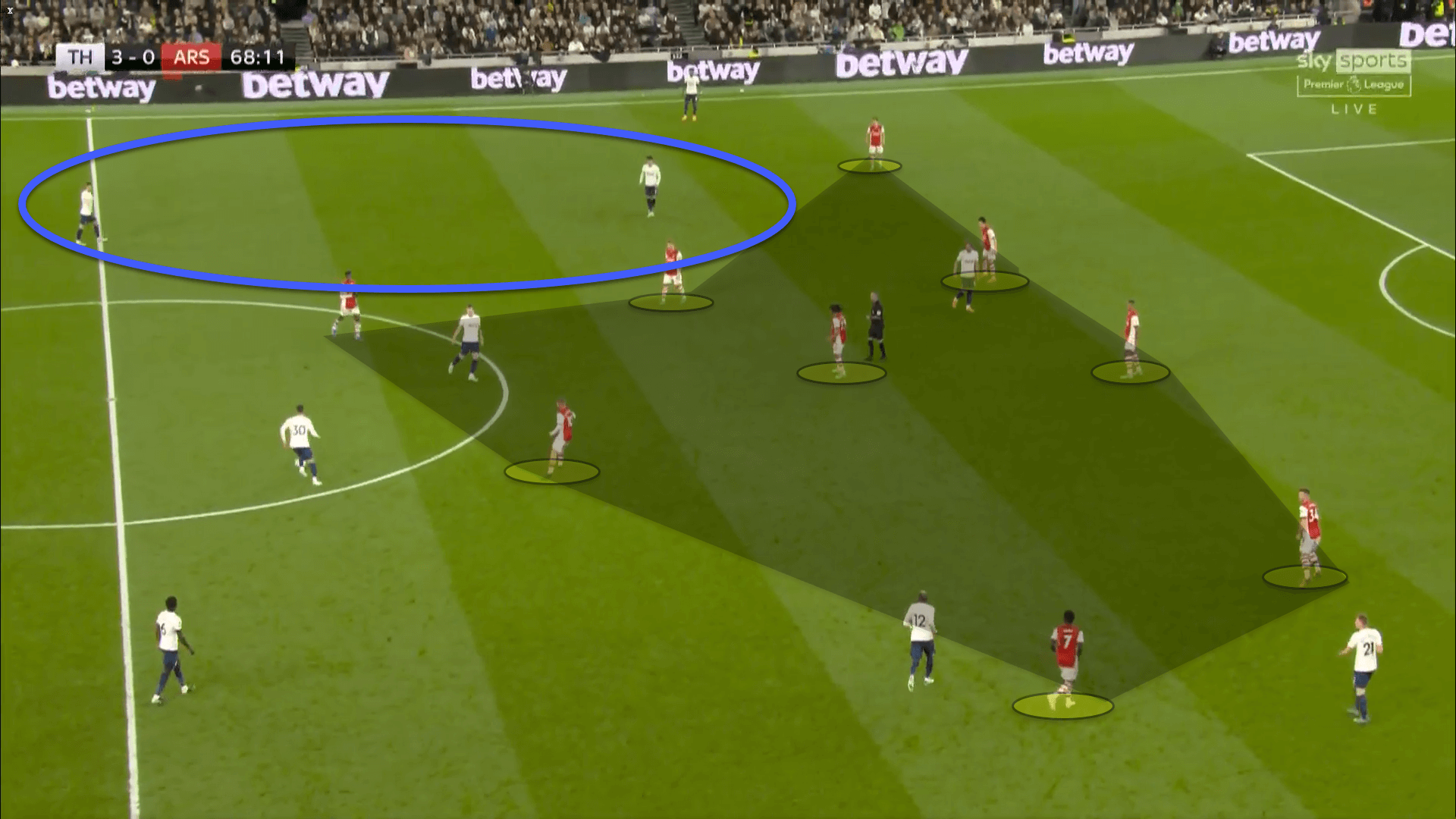
One of the ways that Spurs would try to break Arsenal’s low block down was by creating wide overloads, before quickly shifting the ball over to the far halfspace and trying to reach Kane’s feet from there.
The theory was that once Tottenham formed the wide overload, Arsenal’s defensive shape would shift over to the ball-side. By quickly playing it back inside, Spurs were trying to take advantage of any gaps in the defensive unit before the Gunners could regain a solid structure.
This worked incredibly well for Spurs’ third and final goal of the game when Sanchez found Kane’s feet.
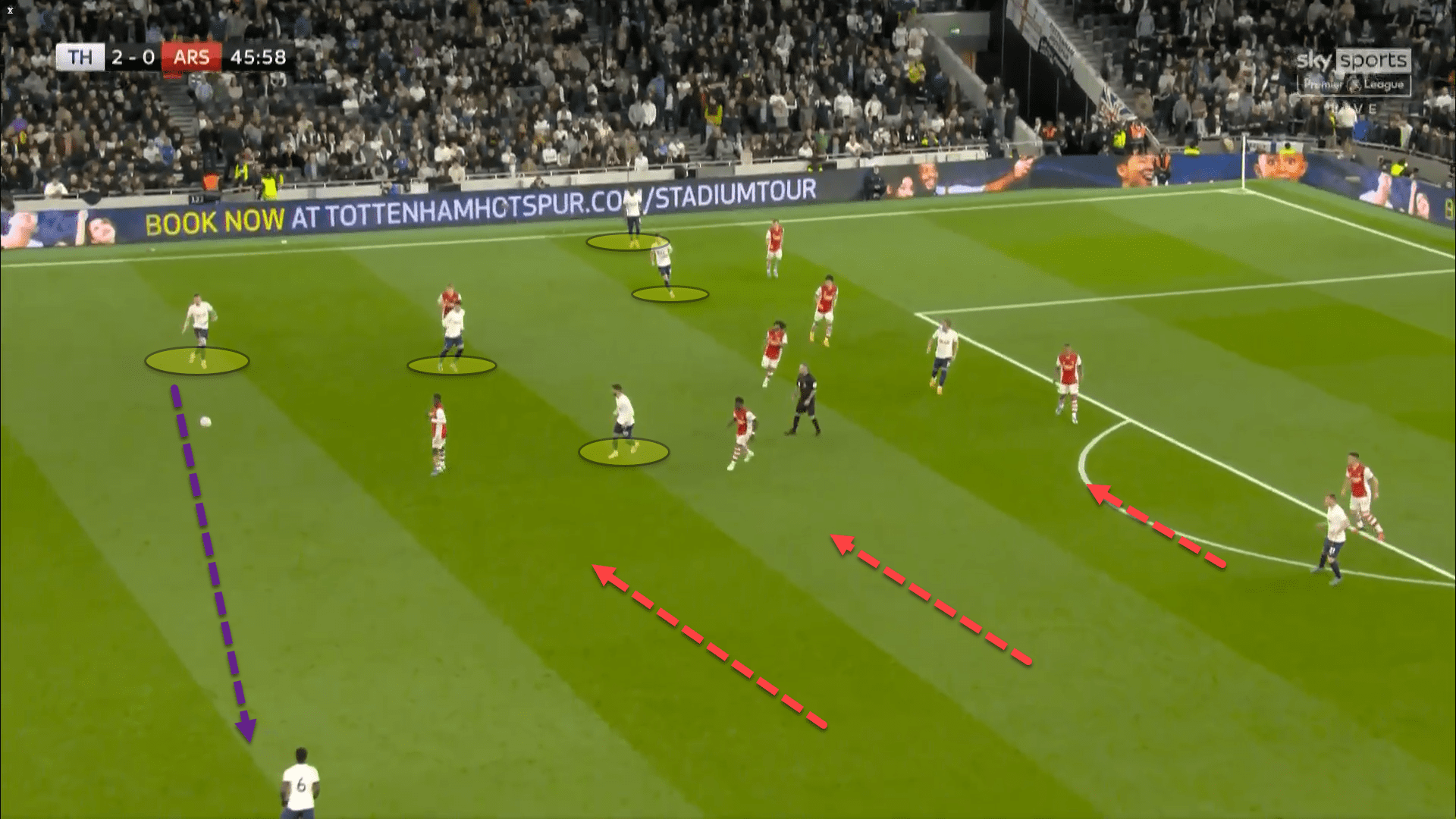
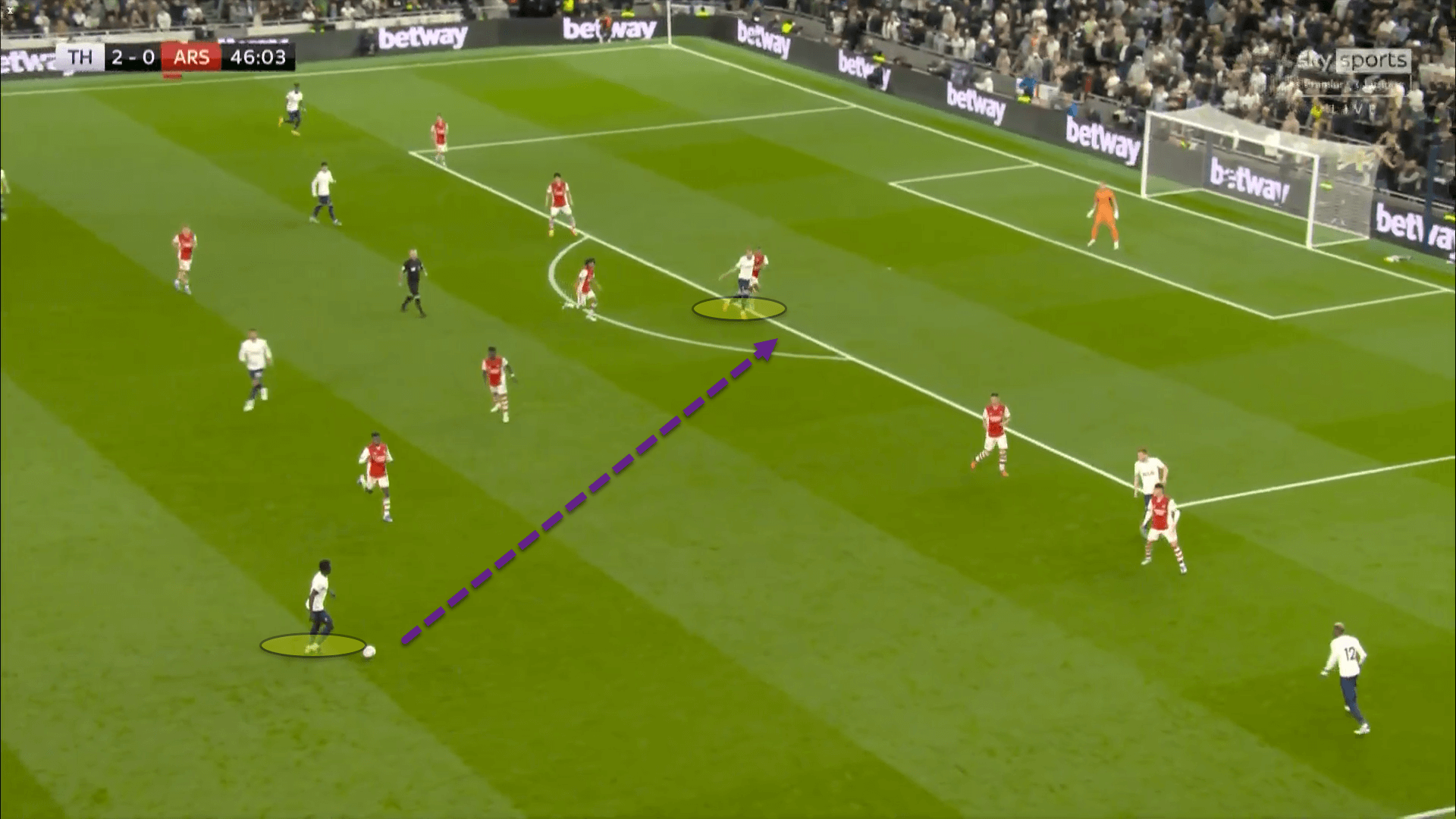
The overload was created on the left. The ball was then switched to Sanchez in the halfspace. Arsenal failed to regroup in time before the Colombian defender played to the feet of Kane, and from there the goal was created. A marvellously well-worked move by Spurs.
These wide overloads were also good for getting players into optimal crossing positions on the flanks, particularly down the right. Emerson’s crossing was a predominant feature of Tottenham’s attacking arsenal if you will excuse the incredibly intentional pun.
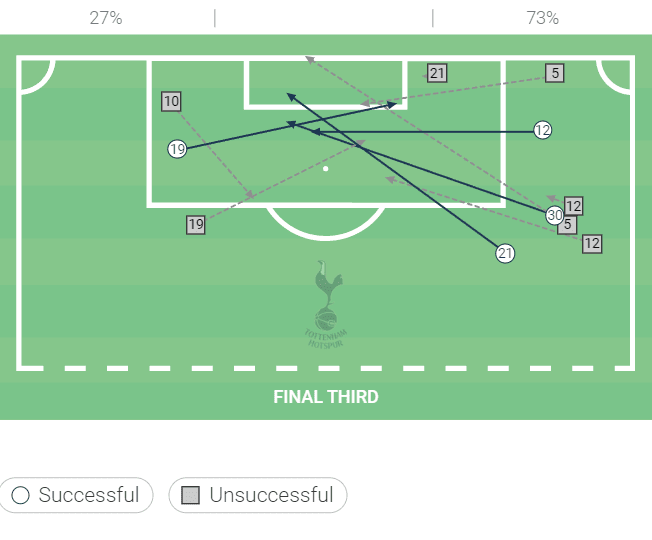
There was a high volume of crosses to the back-post as well from Tottenham which Arsenal really struggled to deal with. This variation even led to Arteta’s side giving away a penalty in the first half when Son was brought down by Holding who failed to deal properly with the cross.
Conclusion
Bragging rights were handed to Tottenham Hotspur, much to the disgust of Mikel Arteta. His side had hit a major roadblock in their hunt for a top-four finish for the first time in six years.
Regardless, Arsenal are still leading the way, and avoiding any slip-ups in the final two games of the campaign will see them sail safely back to shore. However, with Spurs having an objectively easier run-in while breathing down their rivals’ necks, it will be a nervy ending to the season for the youthful Gunners.






Comments